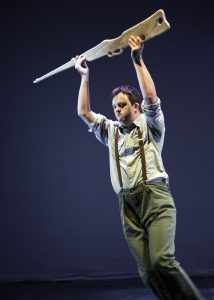arts: dance
The contribution of people with learning disabilities during the First World War makes for a moving dance performance. Tracey Harding meets the people behind it
Several dance companies across the country are proving that dance for people with learning disabilities can be inspiring and empowering.
One such group is Magpie Dance, a company of people with learning disabilities based in Bromley, Kent, who are performing modern contemporary dance to a consistently high standard.
The group aims to show that learning disability is not a barrier to achieving potential through dance, and participants gain opportunities to work with professional companies and have many chances to perform in public.
Magpie’s founder, Avril Hitman, worked for many years with different groups of people in social service centres, community venues and special schools. Looking to expand her work with people with learning disabilities, she received grant funding to progress Magpie’s work, and the company became a registered charity in 1997.
Magpie has moved from strength to strength with co-artistic directors Natasha Britton and Alison Ferrao, and now offers dance training to more than 300 children and adults with learning disabilities each year. They provide inclusive, professional training in the community to teachers and fitness instructors, and work with the NHS to provide inpatient training for people with dementia and learning disabilities.
War work
Last summer, I met general manager Laura Graham and dropped in on rehearsals with the adult choreographers group. Six adult dancers with learning disabilities were rehearsing with two choreographers under the tutelage of Ferrao. The group were rehearsing for a performance to commemorate the 100th anniversary of the First World War.
With a musician drumming alongside them, the group used slow motion to portray wading through mud and crawling through tunnels. The group was impressively focused and knowledgeable in contemporary dance technique, contributed ideas and were extremely supportive of each other.
In the past they have studied dance design and performed their own creations based on influential modern dance choreography, including the work of the great Pina Bausch. A previous performance was an interpretation of Anne Teresa de Keersmaeker’s Rosas danst Rosas, which took place in a local shopping centre, and incorporated the lifts and escalators.
Pari Naderi; Magpie dance: shopping centre
After rehearsals, dancers Megan and Hannah were enthusiastic and articulate about the opportunities and support that Magpie had offered them. They had enjoyed researching the First World War and they were looking forward to performing it.
In December, I attended the performance developed from the rehearsals I had seen in the summer. Hidden Impact involved the whole Magpie company, from juniors upwards, and was held at Langley Park Centre of Performing Arts.
The performance was based on the research of Dr Lee Humber of Ruskin College, Oxford, and self-advocacy group My Life, My Choice, who collaborated closely with Magpie to develop the production.
An exhibition of research, photographs and film was on display in the foyer, which reinforced the tragedy of the war. Some of the background material was based on the family lives of some of the dancers.
Hidden Impact was Magpie’s interpretation of the stories of people with learning disabilities and their contributions during the First World War, from those who were moved from asylums when these were requisitioned as war hospitals to those who fought on the frontline.
The research highlighted the valuable contributions that people with learning disabilities made to history which have never been acknowledged or recognised.
Dancers researched their own family histories, and some of these wartime experiences were woven into the performance. Accompanied by a live band, the dancers showed a series of vignettes, portraying life during wartime, each section – Victorian Street Games, Semaphore and Trenches – introduced by a voiceover narrator.  The performances were poignant and beautifully heartfelt; one solo piece performed by Jamie from the adult choreographers group explored the condition of shellshock.
The performances were poignant and beautifully heartfelt; one solo piece performed by Jamie from the adult choreographers group explored the condition of shellshock.
Drawing movement ideas from Young Men by BalletBoyz and Dust by Akram Khan, the dancer reacted to the sounds and atmosphere of bombing and shooting in the trenches.
 The overall performance from all the dancers was extremely moving and incredibly powerful. The finale was performed to a song written by one of Magpie’s choreographers which saw the dancers holding up labels they had chosen for themselves rather than those that others have placed on them.
The overall performance from all the dancers was extremely moving and incredibly powerful. The finale was performed to a song written by one of Magpie’s choreographers which saw the dancers holding up labels they had chosen for themselves rather than those that others have placed on them.
Magpie Dance is a shining example of how a combination of talent, dedication and opportunity can lead to dance work produced by people with learning disabilities of an extremely high standard that is wonderful to watch.
Like many other organisations, Magpie Dance finds funding is a continuous challenge – it receives grants from Arts Council England, Heritage Lottery and Lewisham Council among others. Given its continuously high standard of work and undoubted benefits to the social skills and mental health of participants, it is essential that Magpie is able to continue its work.
Find out more about Magpie Dance and watch the performance of Hidden Impact at www.magpiedance.org.uk
If you don’t subscribe but would like to support us, every small donation helps us continue our work. No donation too small. You can make this for no charge at Paypal Giving using a debit or credit card. DONATION
If you shop on line, why not join our supporters at easy fundraising. Costs you nothing but every purchase makes a small charitable donation to us. https://www.easyfundraising.org.uk/causes/clinitiatives/


